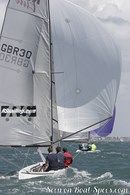RS Elite
Sailboat specifications
The RS Elite is a 24’4” (7.4m) sport keel boat designed by Phil Morrisson (United Kingdom). She was built since 2004 (and now discontinued) by RS Sailing (United Kingdom).
RS Elite's main features
- Model
- RS Elite
- Hull type
- Monohull
- Category
- Sport keel boat
- Sailboat builder
- Sailboat designer
- Country
- United Kingdom
- Construction
- GRP (glass reinforced polyester):
Sandwich foam fiberglass vinylester - First built hull
- 2004
- Last built hull
- Discontinued
- Appendages
- Keel : fin with bulb
- Helm
- Single tiller
- Rudder
- Single spade rudder
- Unsinkable
- No
- Trailerable
- Yes
- EC design categoryiThe CE design category indicates the ability to cope with certain weather conditions (the sailboat is designed for these conditions)
A: Wind < force 9, Waves < 10m
B: Wind < force 8, Waves < 8m
C: Wind < force 6, Waves < 4m
D: Wind < force 4, Waves < 0,5m - C
- Standard public price ex. VAT (indicative only)
- N/A €
RS Elite's main dimensions
- Overall length
- 24’ 4”7.4 m
- Hull length
- 24’ 4”7.4 m
- Waterline length
- 21’ 8”6.6 m
- Beam (width)
- 5’ 7”1.72 m
- Draft
- 3’ 7”1.1 m
- Light displacement (MLC)
- 2150 lb975 kg
- Ballast weight
- 1378 lb625 kg
- Ballast type
- Lead
RS Elite's rig and sails
- Upwind sail area
- 249 ft²23.1 m²
- Downwind sail area
- 439 ft²40.8 m²
- Mainsail area
- 170 ft²15.8 m²
- Genoa area
- 79 ft²7.3 m²
- Symmetric spinnaker area
- 269 ft²25 m²
- Rigging type
- Sloop Marconi fractional
- Mast configuration
- Deck stepped mast
- Rotating spars
- No
- Number of levels of spreaders
- 1
- Spreaders angle
- Swept-back
- Spars construction
- Carbon fiber mast and aluminum boom
- Standing rigging
- Continuous
RS Elite's performances
- Crew
- 3
- PY (Portsmouth Yardstick) ratingiPortsmouth Yardstick is an empirical rating system allowing small sailboats (dinghies included), of different sizes and designs, to race each other fairly. Therefore, by comparing these values, we can have an indication of the relative speed of 2 boats.
- 938
- Upwind sail area to displacementiThe ratio sail area to displacement is obtained by dividing the sail area by the boat's displaced volume to the power two-thirds.
The ratio sail area to displacement can be used to compare the relative sail plan of different sailboats no matter what their size.
Upwind: under 18 the ratio indicates a cruise oriented sailboat with limited performances especially in light wind, while over 25 it indicates a fast sailboat. - 253 ft²/T23.49 m²/T
- Downwind sail area to displacementiThe ratio sail area to displacement is obtained by dividing the sail area by the boat's displaced volume to the power two-thirds.
The ratio sail area to displacement can be used to compare the relative sail plan of different sailboats no matter what their size. - 447 ft²/T41.49 m²/T
- Displacement-length ratio (DLR)iThe Displacement Length Ratio (DLR) is a figure that points out the boat's weight compared to its waterline length. The DLR is obtained by dividing the boat's displacement in tons by the cube of one one-hundredth of the waterline length (in feet).
The DLR can be used to compare the relative mass of different sailboats no matter what their length:
a DLR less than 180 is indicative of a really light sailboat (race boat made for planning), while a DLR greater than 300 is indicative of a heavy cruising sailboat. - 96
- Ballast ratioiThe Ballast ratio is an indicator of stability; it is obtained by dividing the boat's displacement by the mass of the ballast. Since the stability depends also of the hull shapes and the position of the center of gravity, only the boats with similar ballast arrangements and hull shapes should be compared.
The higher the ballast ratio is, the greater is the stability. - 64 %
- Critical hull speediAs a ship moves in the water, it creates standing waves that oppose its movement. This effect increases dramatically the resistance when the boat reaches a speed-length ratio (speed-length ratio is the ratio between the speed in knots and the square root of the waterline length in feet) of about 1.2 (corresponding to a Froude Number of 0.35) . This very sharp rise in resistance, between speed-length ratio of 1.2 to 1.5, is insurmountable for heavy sailboats and so becomes an apparent barrier. This leads to the concept of "hull speed".
The hull speed is obtained by multiplying the square root of the waterline length (in feet) by 1.34. - 6.24 knots
RS Elite's auxiliary engine
- Engine(s)
- Outboard engine
- Engine(s) power
- 4 HP
RS Elite's accommodations and layout
- Cockpit
- Center cockpit



RS Sailing RS Elite sailplan - - 2/6
Picture extracted from the commercial documentation © RS Sailing
Picture extracted from the commercial documentation © RS Sailing




Similar sailboats that may interest you:
Sailboats
First built hull
Hull length
1992
24’ 6”7.48 m
1992
24’ 6”7.48 m
2015
23’7 m
1994
29’ 6”8.98 m
2015
24’ 7”7.5 m
2015
24’ 7”7.5 m
2013
24’ 7”7.5 m
1961
22’ 7”6.9 m
2016
22’6.7 m
1990
26’7.93 m
1993
26’ 2”8 m
1983
22’ 6”6.85 m
2012
22’ 8”6.93 m
2012
23’ 4”7.09 m
2006
24’7.32 m